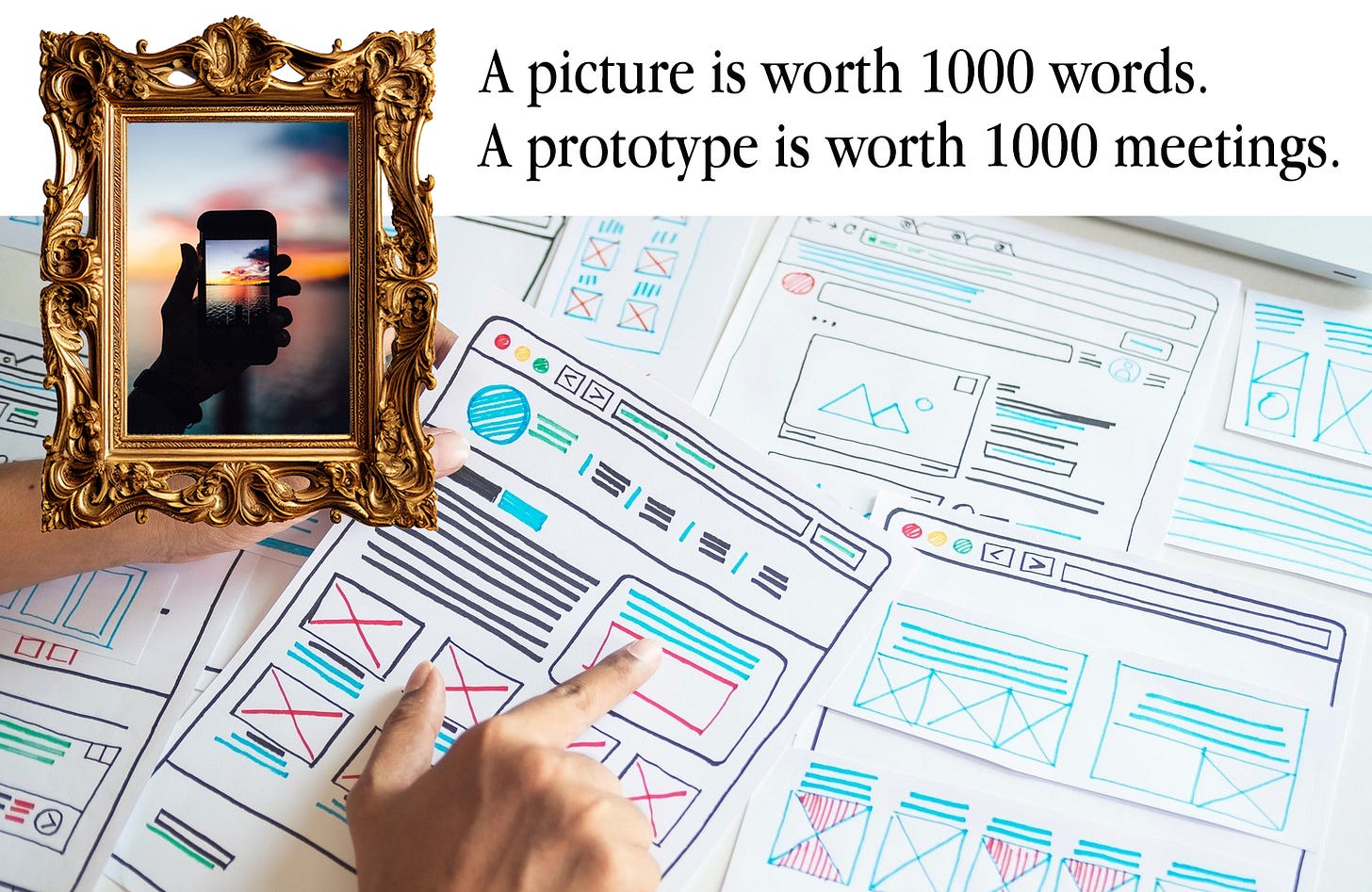A picture is worth 1000 words. A prototype is worth 1000 meetings.
Everything is a ‘delusion’ until there is a prototype.
Everything is a ‘delusion’ until there is a prototype.
In the world of design, communication is as critical as creativity. The age-old adage "a picture is worth a thousand words" profoundly resonates with every designer, but those in the field of product and interface design also adhere to another crucial principle: "a prototype is worth a thousand meetings." This article delves into the importance of these concepts, highlighting why they are indispensable tools for designers striving to transform visions into tangible realities.
The Power of Visuals in Design
Visual communication is one of the most effective ways to convey complex information quickly and clearly. This is why a well-crafted image or design can speak volumes more than a lengthy description. For designers, the ability to create visuals—whether they are sketches, wireframes, or detailed graphics—is not just about artistic expression; it’s about making ideas accessible. Visuals serve multiple purposes:
Clarification: They help clarify ideas that are difficult to express verbally.
Engagement: Images can engage stakeholders more effectively, evoking emotions and responses that words alone cannot.
Efficiency: Visuals can cut through the ambiguity of language, providing a universal language that transcends cultural and linguistic barriers.
Great designers harness the power of visuals not just to present an idea, but to iterate on it, refine it, and bring others along on the journey of creation. In this process, every visual serves as a building block in the construction of a final product.
The Value of Prototyping
While a picture may be worth a thousand words, a prototype can be worth a thousand meetings. Prototypes bring an additional layer of understanding and interaction to the design process, offering a tangible, interactive representation of a product far more effectively than static images or detailed plans. They are crucial for several reasons:
Testing and Feedback: Prototypes allow designers to test their concepts in real-world scenarios and gather feedback that is essential for iterative development.
Stakeholder Engagement: They help bridge the gap between concept and reality, allowing stakeholders to experience and interact with a product before it is fully developed. This can align expectations and foster buy-in more effectively than any presentation or document.
Error Minimization: Early prototyping can identify usability issues and other problems that might not be evident from drawings alone, saving time and resources in the long run.
Prototyping is not just about building a model of the final product; it’s about testing theories, challenging assumptions, and engaging in a dialogue with the end user. This process reduces misunderstandings and refines the product in a way that meetings alone could never achieve.
Integrating Visuals and Prototypes in the Design Process
Integrating both strong visuals and effective prototypes into the design process is crucial for any project's success. This integration allows designers to communicate more effectively with all stakeholders involved, from team members and management to clients and end-users.
Each visual and prototype iteration brings clarity and closer alignment with the user’s needs and expectations, reducing the cycle of revisions and meetings that are often needed to explain or defend a design choice. Instead, the focus can shift to collaborative improvement and innovation.
Accelerates Decision-Making
Prototyping significantly speeds up the decision-making process. When stakeholders can see, touch, and use a prototype, they gain a clearer understanding of the product’s potential and limitations. This hands-on experience is far more effective than speculative discussions based on documents or digital models. As a result, decisions can be made more quickly and confidently, pushing the project forward without the delay of back-and-forth meetings.
Reduces Development Time and Costs
By identifying and solving problems early in the development process, prototypes can save considerable time and resources. Changes made during the prototyping phase are usually less costly compared to those made in later stages of development. This proactive problem-solving approach prevents the often extensive and expensive revisions that can occur after a product has been fully developed or launched.
Builds Stakeholder Engagement and Support
Prototypes engage stakeholders in a way that conceptual presentations cannot. By interacting with a working model, stakeholders can see the practical implications of design choices and contribute constructively. This engagement is crucial not only for gathering valuable input but also for building enthusiasm and support for the project. A well-executed prototype can be a persuasive tool in securing buy-in from higher-ups or external supporters.
Facilitates Iterative Design
The tangible nature of prototypes makes them ideal for supporting an iterative design process. Each iteration can be tested and modified based on solid feedback, gradually improving the product's design and functionality. This iterative process is central to modern design methodologies like Agile and Lean, where rapid prototyping and continuous improvement are key to achieving optimal results.
Conclusion
For a great designer, the ability to effectively use both pictures and prototypes is essential. These tools are not just about making designs appealing; they are about making them work in the real world. By mastering visual communication and prototyping, designers can ensure their visions are not only seen but understood and brought to life with fewer obstacles. This is the essence of what it means to not just design, but to execute well.










